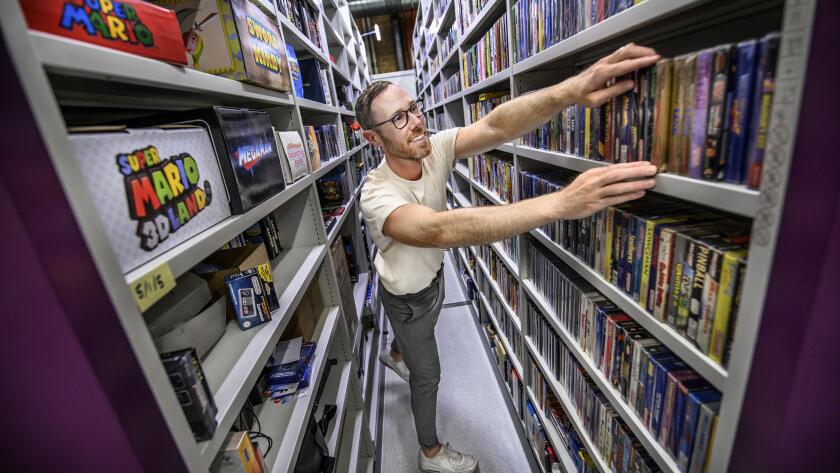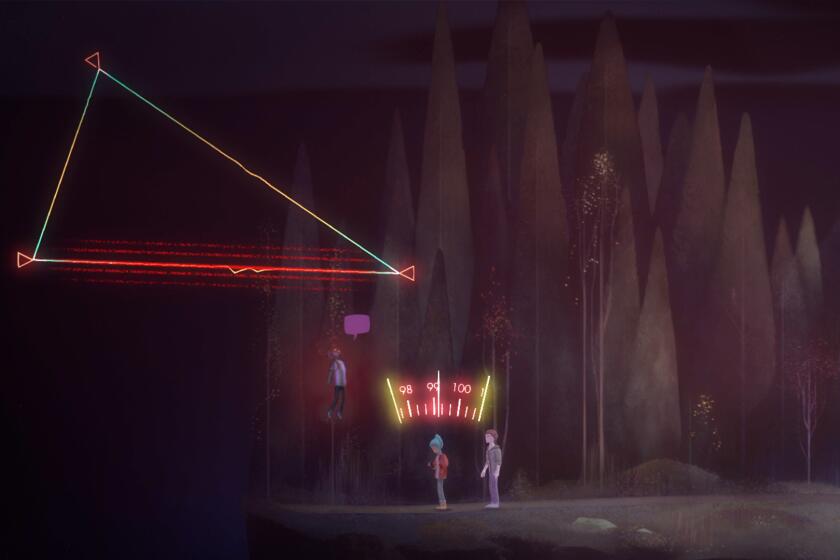- Share via
Swedish gaming personality David Bostrom browses the Embracer Games Archive, an effort by gaming giant Embracer to collect a copy of every video game ever made. (Video by Jackeline Luna and photo by Jenny Ingemarsson / For The Times)
- Share via
KARLSTAD, Sweden — Like so many on-screen action heroes, she was elbowed aside when newer stars appeared and started grabbing more viewers with bigger weapons, better special effects and more elaborate adventures.
That’s when Lars Wingefors spied an opportunity and swooped in.
Earlier this year, the little-known Swedish billionaire bought the rights to British archaeologist Lara Croft and the vehicle that turned her into a household name. After debuting 26 years ago, “Tomb Raider” went on to become one of the best-selling video game franchises of all time, spawning lucrative spinoffs and movies starring Angelina Jolie and Alicia Vikander, before faltering as bigger games and mobile apps appeared and gaming moved away from its core teenage male audience to young girls, college students and families.
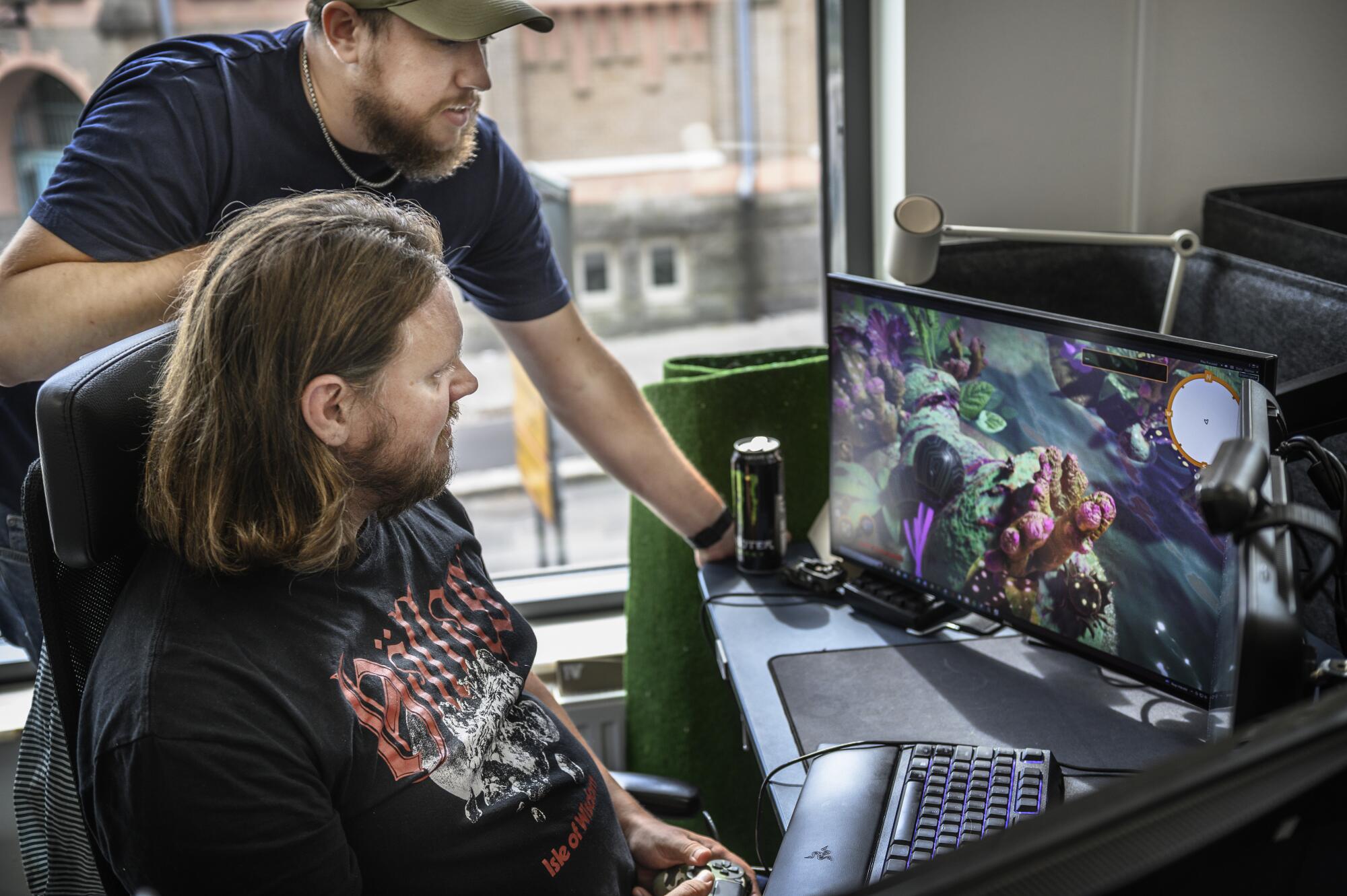
Wingefors’ company, Embracer, purchased “Tomb Raider” from San Mateo-based Crystal Dynamics, along with the rights to dozens of other game titles and development studios belonging to its parent company in May for $300 million — spare change in the $220-billion worldwide gaming industry. The goal? To buy relatively cheap, remake, relaunch and profit big.
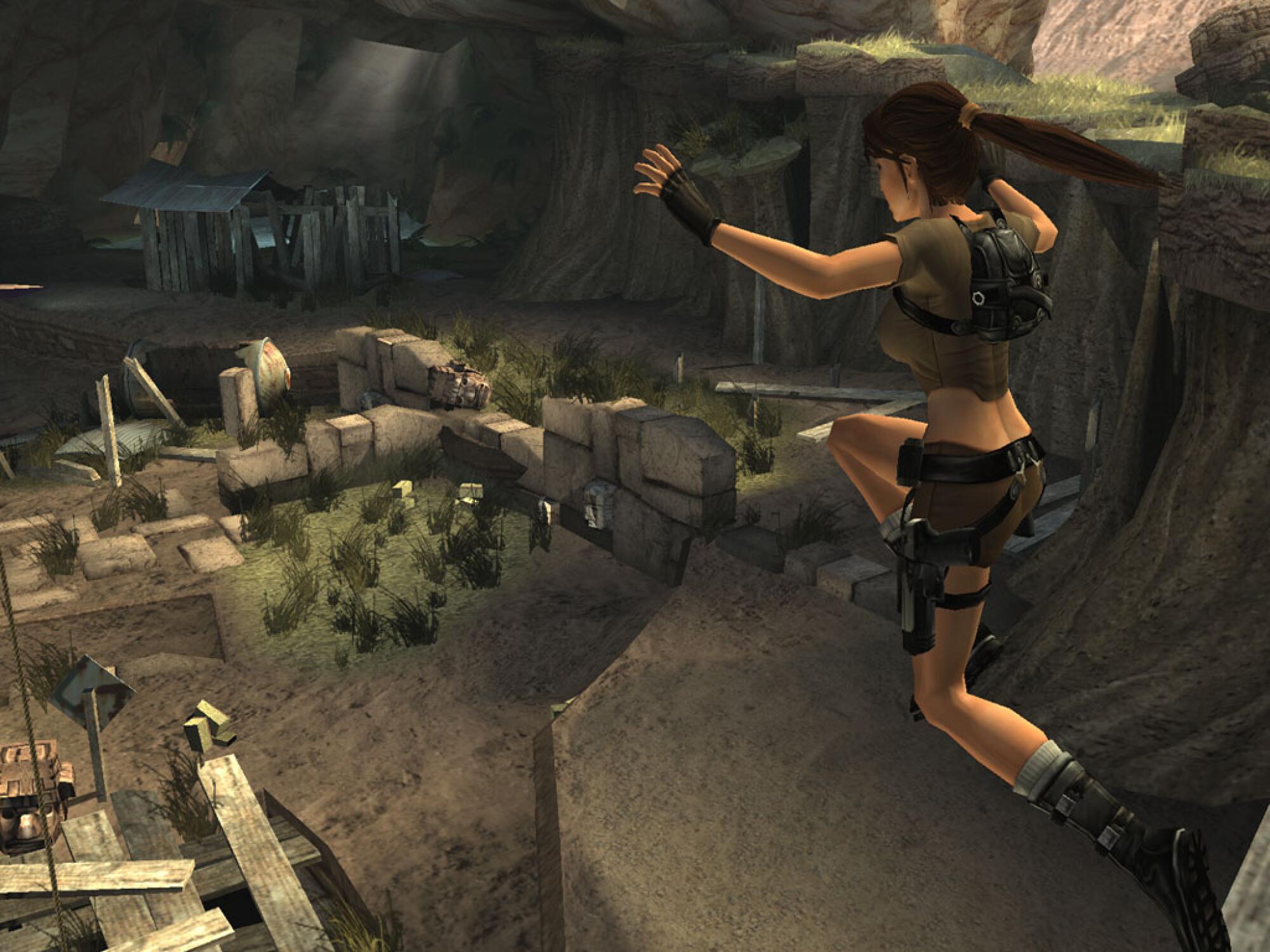
In a matter of years, Embracer has snapped up hundreds of game companies, publishers and intellectual property rights from Los Angeles to Mumbai, allowing Wingefors, its co-founder and chief executive, to quietly build Europe’s biggest gaming group. Today, Embracer is a $5.7-billion publicly traded company headquartered here in Karlstad, Sweden — Wingefors’ sleepy hometown of 65,000 people, about 160 miles west of Stockholm — and owns more video game studios than any other corporation in the world.
A growing number of them are in California, where modern gaming was born in the Bay Area with Atari and “Pong” in the 1970s before Japan took over the gaming console world with Nintendo, Sega and PlayStation. In the last two decades, the power centers of gaming have become more international, and some of the biggest game makers are once again on the U.S. West Coast.
Netflix believes games are the future, but after Google bowed out of the medium, should developers be wary?
They include Xbox maker Microsoft in Redmond, Wash., and Activision Blizzard, the creators of the current bestselling game series “Call of Duty,” in Santa Monica. In February, Super Nintendo World, an immersive theme park based on the Mario Bros. franchise, will open at Universal Studios Hollywood.
For Wingefors and the programmers across the world who dream of having the next hit game, the Golden State is a prime destination.

“A lot of what is happening in the world originates in California. Gaming is not an exception to this,” says Wingefors, 45. “We’re in this space now that we call transmedia — games that are relevant to Hollywood, movies that can become games. That’s where we want to be and how important this state is.
“We want a lot of games and to make them the best,” Wingefors adds. “So we make acquisitions.”
He buys games that are either little-known or past their prime but have dedicated followings, such as “Tomb Raider,” “Legacy of Kain,” “Duke Nukem” and a handful of “SpongeBob SquarePants” titles, which haven’t seen new releases for years. This month, Amazon Games announced a deal to publish the next “Tomb Raider.”
Embracer-owned studios are also upgrading properties such as “Goat Simulator,” a PC and console game whose concept is exactly as it sounds — simulating the life of a goat, albeit one in the city with the task of creating as much havoc and destruction as possible.
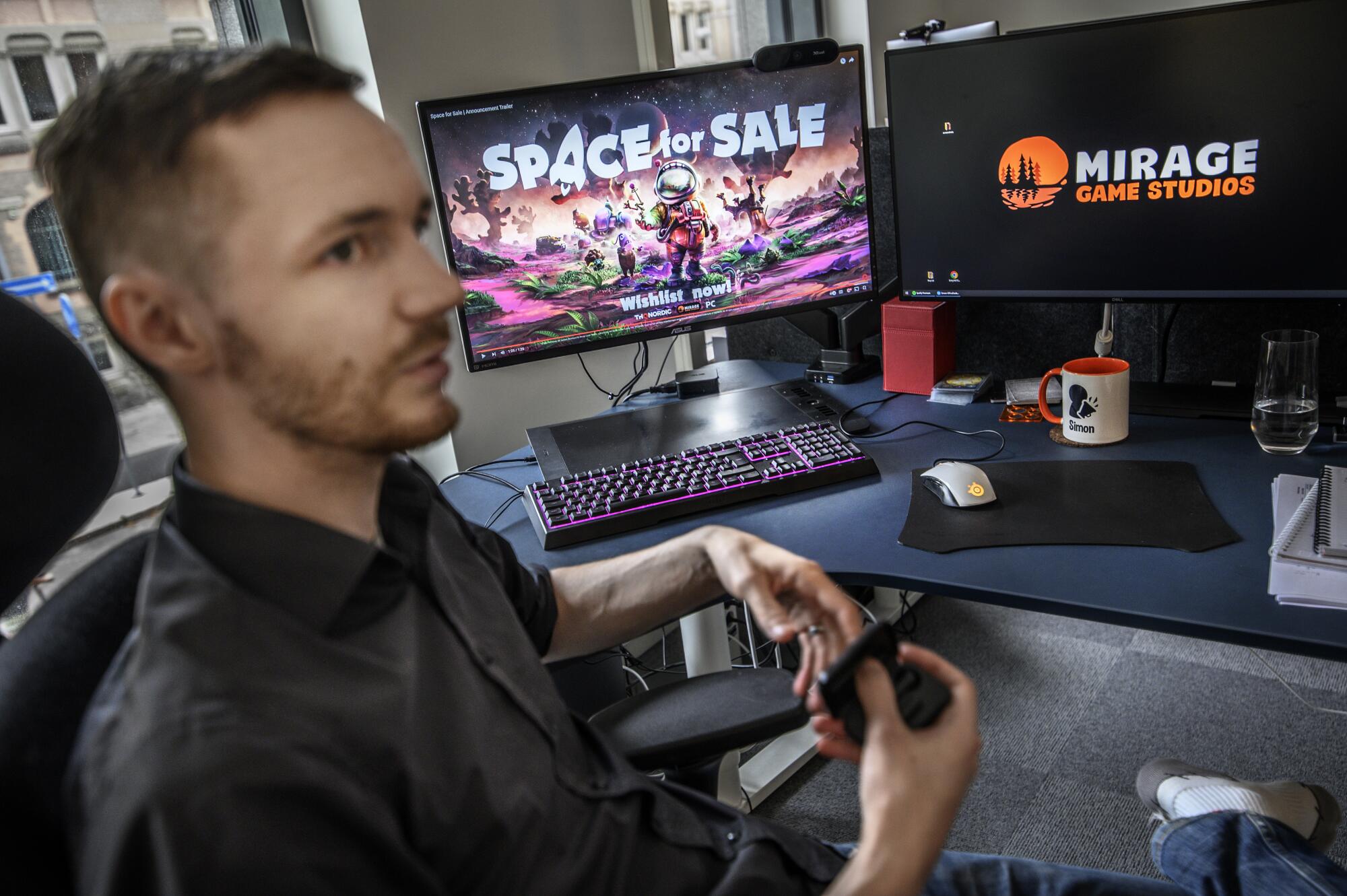
In the last year, Wingefors has set his sights beyond games, purchasing the rights to the “Lord of the Rings” franchise from the Bay Area group that manages derivatives of J.R.R. Tolkien‘s literary works, acquiring a French company that’s among the world’s largest board and card game makers and buying the Oregon-based publisher of “Buffy the Vampire Slayer,” “Hellboy” and “Sin City” comics.
“They’re no Microsoft or Sony. But it seems like they are just trying to get their hands on everything,” says John Hardie, a longtime game collector and co-founder of the National Videogame Museum in Frisco, Texas.
Or as the tech-oriented website the Verge put it: “Embracer Group, the company forging one IP portfolio to rule them all.”
Global California Alert
Receive an alert every time there's a new story in The Times' Global California project, showcasing the connections between California and the world.
You may occasionally receive promotional content from the Los Angeles Times.
The strategy has sparked both criticism and confusion in the gaming world. Some gamers accuse Embracer of sacrificing artistry, while others find the company’s approach scattershot and incoherent. An Embracer developer defends the company’s approach, saying it supports game-makers.
“If you look at them from afar, you might wonder what the company is doing,” says Simon Rojder, a programmer who is the founder of Mirage, a game studio in Karlstad that Embracer absorbed in 2016. “What he [Wingefors] does is find people who know what they are doing and then leaves them alone.
“This company is called the big dragon monster of gaming because they soak up everything. But they give you space to do your work. We feel quite independent, even if on paper we are not.”

Today, Embracer oversees 237 games being developed across 132 studios on every continent except Africa and Antarctica. More than 15,000 employees work for Embracer or a company under its umbrella.
In California, Embracer has a foothold in San Francisco, where it owns a studio that developed the free game “Star Trek Online.” Irvine is home to a recently acquired karaoke company, Singtrix, while SpringboardVR, a company focused on arcade development, is in Los Angeles. In Agoura Hills, Embracer runs global marketing for Vertigo Games, a Dutch games studio and virtual reality group. It also has a distribution contract with Exploding Kittens, an L.A. game studio named after the card game, which shot up in popularity after launching on Kickstarter seven years ago.
Embracer’s rapid expansion comes as tech, gaming and moviemaking collide in a content race to grab the attention and dollars of any consumer they can. Fueled in part by a boom during pandemic-era lockdowns, the gaming industry’s price tag now rivals those of Hollywood and music.
The ad market is shrinking, crypto is in free fall, and venture capitalists want to see profits.
“People used to treat gaming as something teen boys did alone in their rooms and nobody else really cared about, and that was accurate for a very long time,” Hardie says. “But the reality today is nowhere close to that, so every company out there is trying to get a piece of the action.”
Until Embracer’s sudden rise, Europe played only a bit role in the global world of gaming, which routinely pits American game-makers against those in Asia — namely China and Japan, home to Tencent and Sony, respectively. Wingefors is scrambling to carve out room for Sweden, a nation of only 10.5 million people that nonetheless has produced hit games and gaming personalities. If you’ve heard of “Minecraft” or “Candy Crush Saga,” you’ve encountered games created by Swedes.
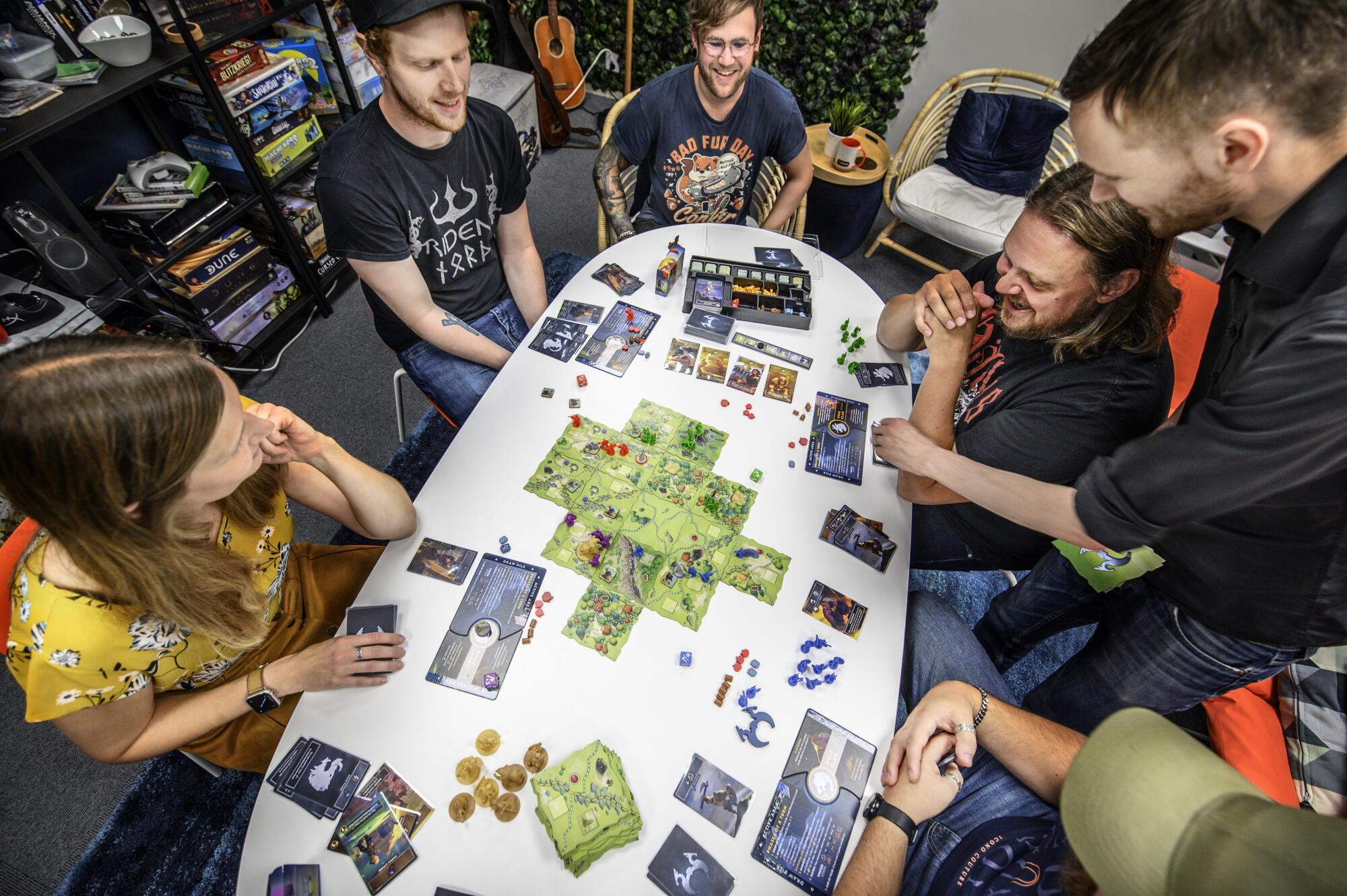
“Hopefully, one day, this city of Karlstad can be kind of a gaming city,” says Wingefors, who, with his crisp suits, slicked-back brown hair and penchant for talking about synergies, intellectual property and return on investment, sounds more like a financier than a gamer.
That’s because that’s what he is.
Raised by divorced parents outside this woodsy city, which is home to several major paper companies, he hawked mail-order comics as a teenager to make spending money. He built up a collection of 50,000 comics before selling them in order to start flipping used video games, mainly old Nintendo cartridges, and dropped out of high school to run a business that he called Nordic Games. It was a seven-shop retail chain in Sweden in the late 1990s, which he sold for more than $7 million.
This story is part of our Global California project
Our correspondents are traveling the globe, sharing stories that examine the complex relationship between the West Coast and the rest of the world.
In the early 2000s, he launched Game Outlet Europe, which bought excess gaming cartridges and CDs and resold them internationally, and financed the development of “We Sing,” a karaoke game for Nintendo Wii. It was a hit, topping Christmas gaming charts in 2009. Within years, Wingefors was investing in international gaming studios, hoping to repeat the win with other games through a company that became Embracer.
For Wingefors, who owns a 21% stake in Embracer, it’s business, rather than a passion for games, that drives him.
“I grew up playing ‘Commodore 64.’ I liked games like any other young person growing up in Sweden. But for me it’s been more about the people, the industry, the business that gets me excited,” he says.
The thirst for a good deal and profits has brought controversy.
Over the summer, Embracer accepted a $1-billion investment from the Saudi Arabian government, a move that critics decried because of the oil-rich kingdom’s dismal record on human rights and free speech. Asked about the 8.1% stake of Embracer that the Arab nation owns through its investment arm, Wingefors says only that he understands there are “different views” on the matter and that his corporation will strive for “inclusion, humanity, freedom and openness.”

In another move that has puzzled observers, Wingefors has hired a team to collect every video game ever made for every platform throughout history. The Embracer Games Archive, announced in May, houses 60,000 games in a 16,000-square-foot industrial warehouse on the outskirts of Karlstad. So far, it has spent $2 million amassing its collection.
Four archivists unload pallets of plastic-sealed games purchased in bulk from auctions and log them into a growing database. David Bostrom, a Swedish YouTuber famous for streaming videos of himself playing from his retro game room in the city of Orebro, runs the operation.
On any given day, his team could be unpacking the Japanese-language catalog for the Famicom — the precursor to the Nintendo system that has made Mario and Luigi as famous as Mickey Mouse for generations since the 1980s — or dusting off old copies of “Final Fantasy,” the 3D role-playing game that sold millions of CDs in the 1990s for PlayStation systems.
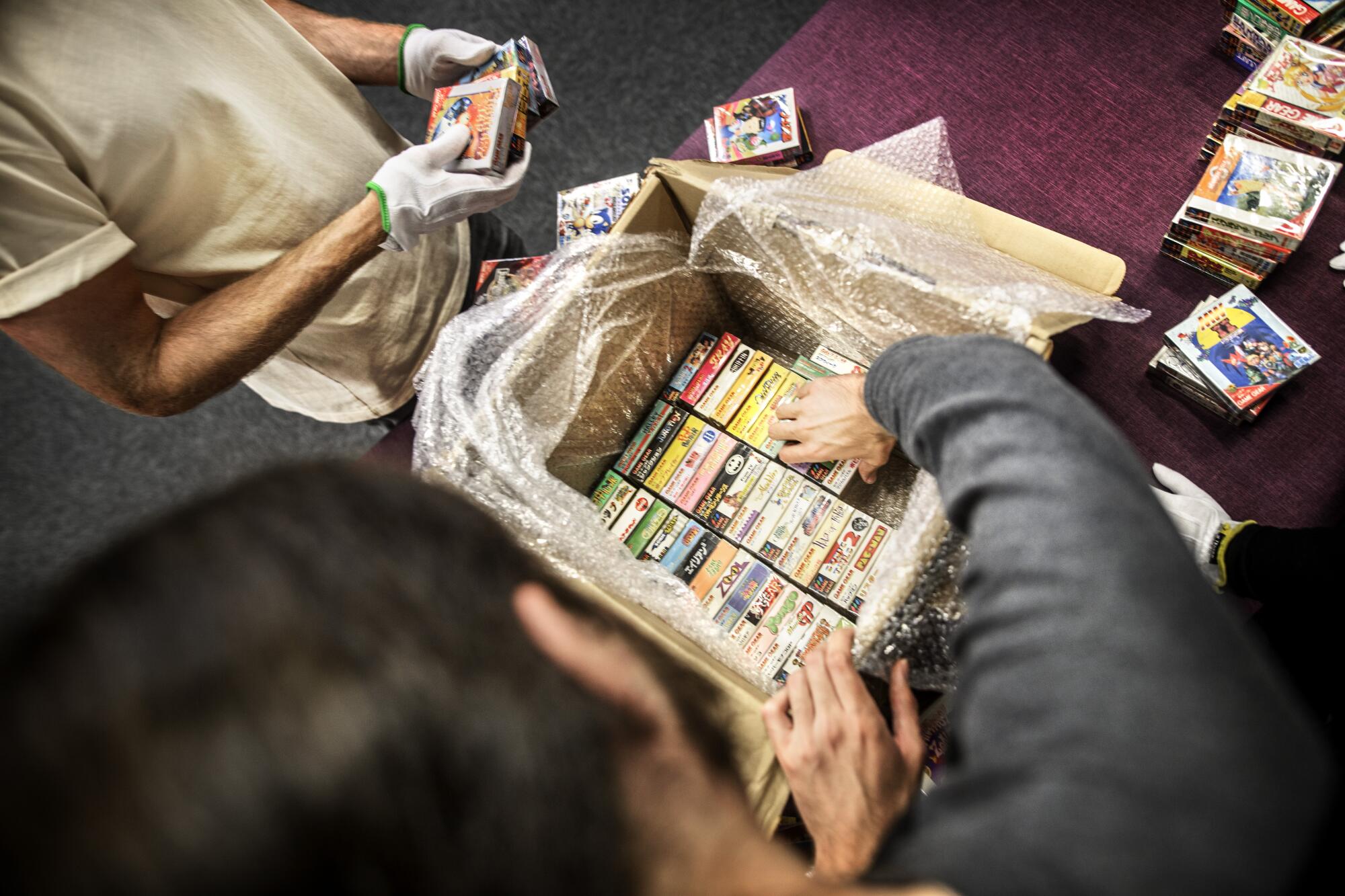
“We are trying to create a kind of history or heritage museum,” says Bostrom. “Embracer has so many games and studios but far from everything out there, so we want to give a picture of the complete story of gaming.”
Archives and museums are usually open to researchers or the public. For now, Embracer’s is private.
Some have criticized the effort as simply another way for Embracer to collect intellectual property. If he can’t outright own the rights to games, critics say, Wingefors can at least own the last remaining copies of them.
Not surprisingly, Wingefors sees it differently.
“Legacy is part of the DNA of gaming companies, of gaming altogether, because this industry is about stories,” he says. “So whether we are bringing a title back to the market or growing an archive, it is our duty to be part of that legacy.”
More to Read
Global California Alert
Receive an alert every time there's a new story in The Times' Global California project, showcasing the connections between California and the world.
You may occasionally receive promotional content from the Los Angeles Times.
